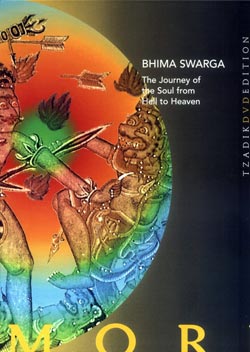|
Heard In
Reviews of artist releases:
cd's, books, magazines, &c.
Ikue Mori
Bhima Swarga
review by Phil Zampino
2007-07-10

Ikue Mori's growth as a video artist had me unprepared for this spectacular work. Tzadik says that Bhima Swarga was years in the making, and through its exquisite image detail and complex psychedelic transitions it's not hard to believe. The design of this DVD package is quite nice, a double gatefold that opens to images from the animation and brief descriptions of the story part that each image represents. Included also is a brief biography on Mori, describing her rise from the drummer in D.N.A., part of the No Wave NY movement, to her adoption of electronics and laptop sound sources, increasingly working with video manipulation and animation. There's also a biography on eclectic modern composer Matthew Welch, who wrote one of the two soundtracks for the movie, and of the Gamelan Dharma Swara group that perform's Welch's soundtrack.
Sadly there is almost no information about the context of the protagonist of this story, Bhima Swarga himself, nor why we're watching him transgress through seven levels of hell to face battle and experience bewildering and edifying encounters. So a little history: The Kertha Gosa pavilion on the island of Bali was built in the early 1700s, and the story of Bhima Swarga is represented in the ceiling through several rows of painting. Bhima Swarga's story comes from the Hindu epic Mahabharata, and is only one story in the about 1.8 million words that make up that major work. Essentially, the mortal Bhima is forced by his mother to rescue from Hell his mortal father (a king) and his second mother, so that he can secure their place in heaven. No mean feat, as the story describes, and I won't spoil the rest, as you can follow along with the story in the inside cover using the chapter display on your DVD player, or by using the chapter images they provide. The story has 18 sections, the longest parts in the beginning as the epic quest is proposed and embarked upon.
Mori's animation uses figures taken directly from the images of Bhima Swarga at the Kertha Gosa pavilion. Those figures are brought to life, posed and placed over sparse backgrounds, upon which Mori applies an incredible array of effects, ancillary artwork, and psychedelic treatment. The story follows logically with a mix of slow establishing scenes placed against high action, at times trippy and extremely rapid, usually pausing to illustrate the lesson each particular hell presents. The characters are in bold colors, and Mori's applications alternately subdues and intensifies those colors. Images are extreme, repeating figures that vary or are treated profoundly, with long but never monotonous battle scenes. Don't make the mistake of putting this on and watching with one eye, or using it as a background (though it could certainly function well that way). Reading along with the chapter descriptions makes the action easy to follow, and reveals some bizarre concepts ethically challenging by modern standards, such as a childless woman who has to nurse a caterpillar in the third hell (I'll spare you what happens to anyone who doesn't become a grandparent!)
There are two soundtracks to go along with the movie, which are selected on the DVD menu without visual clues - the viewer must listen to the different sample of the soundtrack to select which version they'll hear. The first choice is solo Mori, using her laptop as her compositional tool. The other is a score written by Matthew Welch, who wrote for a full gamelan ensemble augmented by Mori's electronics and Welch on saxophone and percussion. Welch's composition is a modern adaptation of traditional Balinese music, appropriate for the manner in which Mori brought the paintings to life. It's a powerful and compelling piece that uses ancient and modern methods to interact with the film. Mori's solo soundtrack is a flexible and fascinating piece of electro-acoustic music that adapts well to the visual telling of the story. She inflects a haunting aspect of Balinese music into her typically slippery and expansive electronics, creating a fluid and dynamic work that complements the visual movement extremely well. Regardless of the choice of soundtrack, Bhima Swarga is a visual and auditory feast, an unusual work of animation from an incredible artist who's work continues to evolve in remarkable ways.
Comments and Feedback:



More Recent Reviews, Articles, and Interviews @ The Squid's Ear...


|
|
|
|

